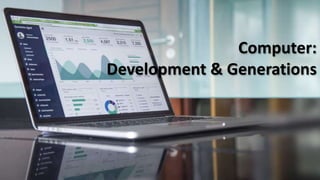
Generations & Development of Computers.pptx
- 3. Development of Computer • The brief history of computer, is a timeline of how computers evolved from their humble beginning to the machines of today that surf the Internet, play games and stream multimedia in addition to crunching numbers.
- 4. Development of Computer • By 1880, the U.S. population had grown so large that it took more than seven years to tabulate the U.S. Census results. • The government sought a faster way to get the job done, giving rise to punch-card based computers but that took up entire rooms.
- 5. • Before the 1500s, in Europe, calculations were made with an abacus Invented around 500BC, available in many cultures (China, Japan, Greece, Rome, etc. • In 1642, Blaise Pascal (French mathematician, physicist, philosopher) invented a mechanical calculator called the Pascaline Evolution of Computer
- 6. • In 1671, Gottfried von Leibniz (German mathematician, philosopher) extended the Pascaline to do multiplications, divisions, square roots: the Stepped Reckoner • None of these machines had memory, and they required human intervention at each step Evolution of Computer
- 7. • In 1822 Charles Babbage (English mathematician, philosopher), sometimes called the “father of computing” built the Difference Engine • Machine designed to automate the computation (tabulation) of polynomial functions (which are known to be good approximations of many useful functions) – Based on the “method of finite difference” – Implemented some storage Evolution of Computer
- 8. • In 1833 Babbage designed the Analytical Engine, but he died before he could build it – It was built after his death, – powered by steam – Enhanced storage capability Evolution of Computer
- 9. Generations of Computers • A generation refers to the state of improvement in the development of a product. • This term is also used in the different advancements of computer technology. • With each new generation, the circuitry has gotten smaller and more advanced than the previous generation before it.
- 10. Generations of Computers • As a result of the miniaturization, speed, power, and memory of computers has proportionally increased. • The computer has evolved from a large-sized simple calculating machine to a smaller but much more powerful machine. • The evolution of computer to the current state is defined in terms of the generations of computer.
- 11. Generations of Computer • Each generation of computer is designed based on a new technological development, resulting in better, cheaper and smaller computers that are more powerful, faster and efficient than their predecessors. • Currently, there are five generations of computer. • The main difference between one generations to the next is in terms of the technology used by them, computing characteristics, physical appearance, and their applications.
- 13. First Generation Computers (1940-1956) • The first computers used vacuum tubes (a sealed glass tube containing a near-vacuum which allows the free passage of electric current) for circuitry and magnetic drums for memory. • They were often enormous in size and taking up entire room. • First generation computers relied on machine language.
- 14. First Generation Computers (1940-1956) • They were very expensive to operate and in addition to using a great deal of electricity, generated a lot of heat, which was often the cause of malfunctions (defect or breakdown). • The UNIVAC and ENIAC computers are examples of first-generation computing devices.
- 15. First Generation Computers Advantages : • It was only electronic device • First device to hold memory Limitations : • Too bulky i.e large in size • Vacuum tubes burn frequently • They were producing heat • Maintenance problems
- 16. Second Generation Computers (1956-1963) • Transistors replaced vacuum tubes and ushered in the second generation of computers. • Second-generation computers moved from cryptic binary machine language to symbolic. • High-level programming languages were also being developed at this time, such as early versions of COBOL and FORTRAN. • These were also the first computers that stored their instructions in their memory.
- 17. Second Generation Computers Advantages : • Size reduced considerably • The very fast • Very much reliable Limitations : • They over heated quickly • Maintenance problems
- 18. Third Generation Computers (1964-1971) • The development of the integrated circuit was the hallmark of the third generation of computers. • Transistors were miniaturized and placed on siliconchips, called semiconductors. • Instead of punched cards and printouts, users interacted with third generation computers through keyboards and monitors and interfaced with an operating system. • Allowed the device to run many different applications at one time.
- 19. Third generation computers Advantages : • ICs are very small in size • Improved performance • Production cost cheap Limitations: • ICs are congested
- 20. Fourth Generation Computers (1971-present) • The microprocessor brought the fourth generation of computers, as thousands of integrated circuits were built onto a single silicon chip. • The Intel 4004 chip, developed in 1971, located all the components of the computer. • From the central processing unit and memory to input/output controls—on a single chip. • Fourth generation computers also saw the development of GUIs, the mouse and handheld devices.
- 22. Fifth Generation Computers (present and beyond) • Fifth generation computing devices, based on artificial intelligence. • Are still in development, though there are some applications, such as voice recognition. • The use of parallel processing and superconductors is helping to make artificial intelligence a reality. • The goal of fifth-generation computing is to develop devices that respond to natural language input and are capable of learning and self-organization.